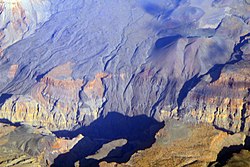| Uinkaret volcanic field | |
|---|---|
 | |
| Highest point | |
| Elevation | 1,555 m (5,102 ft) [1] |
| Coordinates | 36°23′N113°08′W / 36.38°N 113.13°W |
| Geography | |
 | |
| Location | Mohave County, Arizona, US |
| Topo map | USGS Mount Logan |
| Geology | |
| Rock age | 1.2 million years [2] |
| Mountain type | volcanic field |
| Last eruption | 1100 ± 75 years |


The Uinkaret volcanic field is an area of monogenetic volcanoes in northwestern Arizona, United States, located on the north rim of the Grand Canyon. [2]
Contents
Lava flows from the Uinkaret volcanic field that have cascaded down into the Grand Canyon, damming the Colorado River, have been used to date the canyon's carving. [3] One of these cascades is today's Lava Falls. Lava Falls Rapid, below Lava Falls on the Colorado River, is "at all water levels, the most severe rapid in Grand Canyon." [4]
The Colorado River was dammed by lava flows multiple times from 725,000 to 100,000 years ago. [5] While some believe that these lava dams were stable, lasting up to 20,000 years and forming large reservoirs, [6] others think they failed quickly and catastrophically as massive floods. [7] Lava flows traveled downriver 76 miles (122 km) from river mile 178 to 254.[ citation needed ]
One lava flow, from Little Springs, south of Pliocene Mount Trumbull, has a cosmogenic helium age of 1300 ± 500 years BP. Pottery shards dated to between 1050 and 1200 CE were found within the lava flow, produced around the same time as the Sunset Crater eruption in the San Francisco volcanic field on the South Rim. [1]